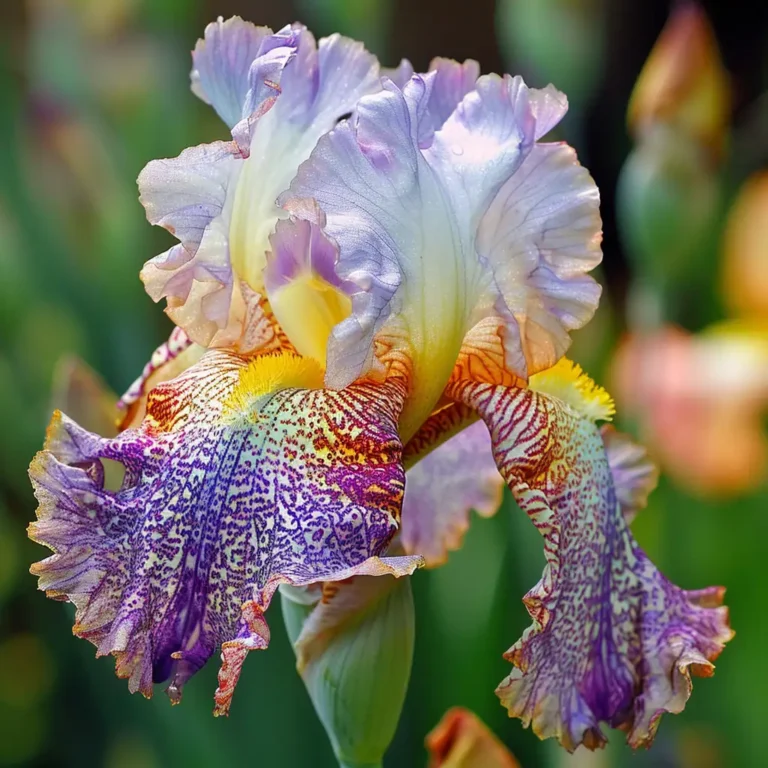Irises, with their striking blooms and elegant form, have long captivated gardeners and flower enthusiasts alike. These beautiful flowers, known for their vibrant colors and unique shapes, bring a touch of grace to any garden. In this article, we’ll explore the fascinating world of irises, from their rich history to tips on growing them successfully.
History of Irises
Irises have a storied past, dating back to ancient times. They hold cultural significance in various regions around the world:
- Origins: Irises are named after Iris, the Greek goddess of the rainbow, symbolizing the wide range of colors found in these flowers.
- Historical Significance: In ancient Egypt, irises were often used in religious ceremonies and depicted in artworks.
- Cultural Importance: In Japan, irises are celebrated during festivals and are believed to ward off evil spirits.
- Famous Varieties: Some of the most renowned varieties include the Bearded Iris, Siberian Iris, and Japanese Iris.
Types of Irises
Irises come in several varieties, each with its unique characteristics. Here are the most popular types:
- Bearded Irises: Known for their distinct “beard” of hairs on the petals.
- Siberian Irises: Slender foliage with elegant, crisp flowers.
- Japanese Irises: Large, flat blooms often used in Japanese gardens.
- Dutch Irises: Often grown for their striking cut flowers.
- African Irises: These blooms are hardy and thrive in various climates.
How to Grow Irises
Growing irises can be a rewarding experience, and with the right care, they can thrive in your garden. Here are some tips to get you started:
Soil Preparation and Ideal Conditions
- Choose a sunny spot with well-drained soil.
- Amend the soil with compost to improve fertility and drainage.
Planting Tips and Techniques
- Plant iris rhizomes shallowly, with the tops just below the soil surface.
- Space them about 12-18 inches apart to allow for growth.
Watering and Fertilization Requirements
- Water regularly, especially during dry spells, but avoid waterlogging.
- Fertilize with a balanced, slow-release fertilizer in early spring.
Common Pests and Diseases
- Watch out for iris borers and aphids.
- Ensure good air circulation to prevent fungal diseases.
Seasonal Care for Irises
Proper seasonal care ensures your irises remain healthy and vibrant throughout the year:
Spring Care Tips
- Remove winter mulch and dead foliage.
- Apply a light layer of compost around the plants.
Summer Maintenance
- Keep the soil moist but not soggy.
- Deadhead spent blooms to encourage more flowers.
Fall Preparation
- Divide and replant overcrowded clumps.
- Cut back foliage to prevent disease.
Winter Protection
- Apply a thick mulch layer to protect rhizomes from freezing.
Designing with Irises in Your Garden
Irises can enhance the beauty of any garden with their stunning blooms. Here are some design tips:
- Companion Plants: Pair irises with daylilies, peonies, and alliums for a colorful display.
- Color Combinations: Mix different iris varieties to create a vibrant palette.
- Garden Layout Ideas: Plant irises in groups or borders for a striking effect.
Irises in Art and Culture
Irises have inspired artists and writers for centuries:
- Famous Artworks: Vincent van Gogh’s “Irises” is one of the most famous paintings featuring these flowers.
- Symbolism: In various cultures, irises symbolize hope, wisdom, and courage.
- Literature and Poetry: Irises often appear in poems and stories, symbolizing beauty and transformation.
The Best Irises for Cut Flowers
Some iris varieties are particularly suited for cut flowers, providing long-lasting beauty in arrangements:
- Top Varieties: Bearded irises, Siberian irises, and Dutch irises are excellent choices.
- Tips for Arranging: Cut irises early in the morning and place them in fresh water immediately.
- Preserving Cut Irises: Change the water daily and keep the arrangement in a cool spot.
Advanced Iris Care Tips
For those looking to take their iris gardening to the next level, here are some advanced care tips:
- Dividing and Transplanting: Divide irises every 3-5 years to prevent overcrowding and promote healthy growth.
- Hybridization and Breeding: Experiment with cross-pollination to create new iris varieties.
- Addressing Common Growth Problems: Troubleshoot issues like yellowing leaves or poor blooming.
FAQs
How long do irises typically bloom?
- Irises generally bloom for a few weeks in spring, with some varieties blooming again in late summer.
What are the best conditions for irises to thrive?
- Irises prefer full sun and well-drained soil.
Can irises grow in pots?
- Yes, irises can be grown in pots with proper drainage and regular care.
How do I prevent my irises from getting diseases?
- Ensure good air circulation, avoid overhead watering, and remove dead foliage promptly.
Conclusion
Irises are a beautiful and rewarding addition to any garden. With their vibrant colors and unique forms, they offer endless possibilities for garden design and floral arrangements. By following the tips and advice outlined in this article, you can enjoy the exquisite beauty of irises in full bloom.

